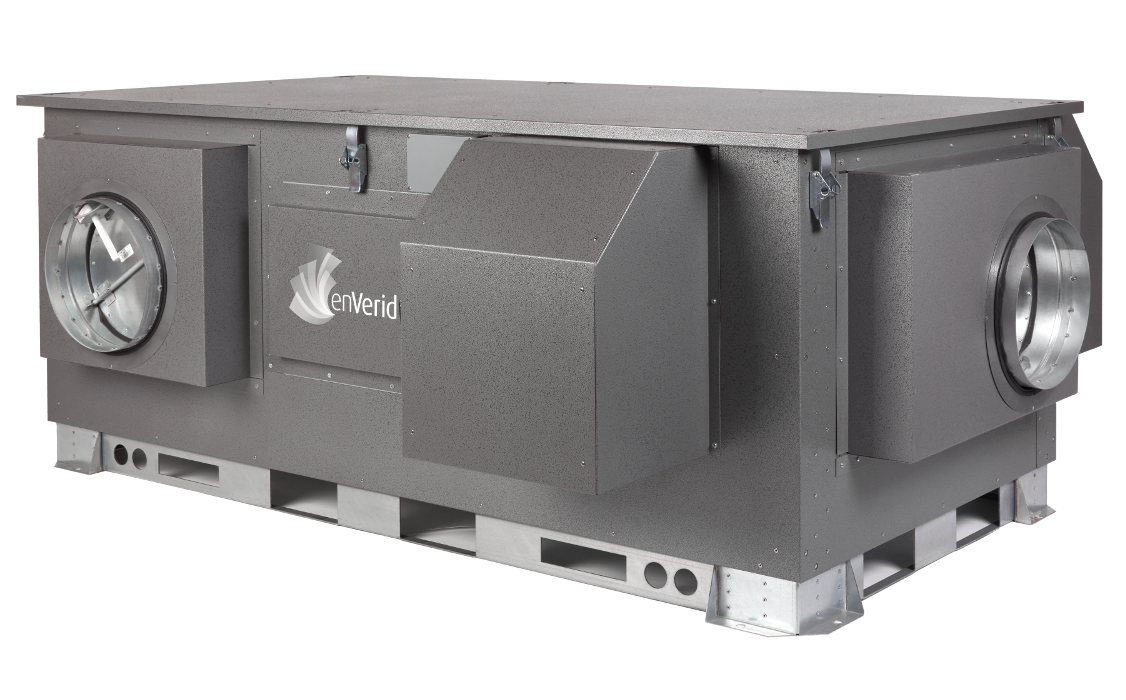by Brianna Crandall — January 31, 2018 — HVAC/IAQ technology provider enVerid Systems announced last week at AHR Expo 2018 the launch of its new HVAC Load Reduction (HLR) module for rooftop installations. Designed for the outdoors, the HLR 1000E-R system builds on the success of enVerid’s HLR modules for indoor deployments in commercial, government and academic buildings.

Designed for the outdoors, the HLR 1000E-R system requires minimal routine maintenance, with cartridge set replacement only once per year, and the robust design delivers a 20+-year operating life.
Dr. Udi Meirav, CEO and founder, enVerid Systems, stated:
Adoption of our HLR solutions has accelerated among Fortune 500 companies and major universities. We have listened closely to the needs in the marketplace and are pleased to meet the demand we’re seeing for an outdoor solution that provides the immediate payback on HVAC designs while increasing energy savings and indoor air quality.
According to enVerid, the HVAC Load Reduction (HLR) rooftop module is a “smart scrubber” that actively and automatically manages HVAC cooling and heating load and indoor air quality (IAQ). The scalable solution is designed to offer an easy side-by-side retrofit with existing HVAC infrastructure with simple turnkey installation, and to extend the lifetime of existing HVAC equipment as well as reduce initial size and capacity required of new HVAC systems.
Instead of the legacy practice of replacing the entire volume of indoor air with outside air every one-to-two hours to minimize concentrations of unhealthy indoor air pollutants, HLR modules clean and recycle indoor air. In doing so, HLR systems reduce the outside air intake required to ventilate a building by 60 to 80 percent, enabling up to a 40 percent reduction in peak heating, ventilation, and air-conditioning (HVAC) capacity and significant equipment savings, claims enVerid.
Additionally, the system is said to decrease annual energy consumption by 20 to 30 percent while improving IAQ for better health, productivity, and satisfaction of building occupants.
The HLR 1000E-R is engineered to safely capture and clean all indoor air of contaminants typical of commercial, education, and government buildings, including carbon dioxide (CO2), volatile organic compounds (VOCs), and aldehydes. Also, bringing in less polluted outside air reduces the introduction of additional harmful contaminants to a building, such as ozone and particulate matter (PM2.5), notes the company.
The system generally has immediate payback, as buildings can invest in lower-capacity and less-expensive HVAC systems, and are eligible for local utility rebate programs that can cover up to half the initial cost, points out enVerid. In addition, implementing the technology along with an IAQ assessment can earn as many as 17 LEED points for buildings, which is over 40 percent of the points required to receive LEED green building certification.
enVerid says the module requires minimal routine maintenance, with cartridge set replacement only once per year, and the robust design delivers a 20+-year operating life.
The HLR 1000E-R system also offers real-time monitoring, reporting and validation, with 24/7 online access to performance metrics, including air quality and real-time validated energy savings, says the company. Ready for any connected building or “Internet of Things” initiative, the module is BACnet compatible, can connect to an existing building management system (BMS), and is LoRa ready, with remote control at your fingertips by computer or smartphone.
Some commercial buildings require extra outside air flow to maintain IAQ, resulting in some areas of the building getting too cold, sparking an increase in complaints from occupants, points out enVerid. This problem is further exacerbated in buildings with higher occupant densities than they were originally designed for — common in open-plan office buildings. By reducing outside air, the HLR 1000E-R system ensures that there are fewer drafts in the building and the HVAC system can more easily maintain temperature and humidity on extreme weather days.
The HLR 1000E-R can be installed during new construction or as a retrofit, and has a double-walled, insulated construction certified for 1,000-hour salt-spray. The technology is compliant to the standards for ventilation defined by the American Society of Heating, Refrigerating and Air-Conditioning Engineers (ASHRAE) Standard 62.1 Indoor Air Quality Procedure (IAQP) and the International Mechanical Code (IMC).
According to enVerid Systems, its HLR technology was awarded the prestigious 2016 R&D 100 Award, and has been recognized by the US Department of Energy, the US General Services Administration’s Green Proving Ground Program, and the U.S. Green Building Council (USGBC).
For an explanation and video of enVerid’s HVAC Load Reduction (HLR) technology or to find out more about the HLR 1000E-R module, visit the enVerid Systems Web site.




